
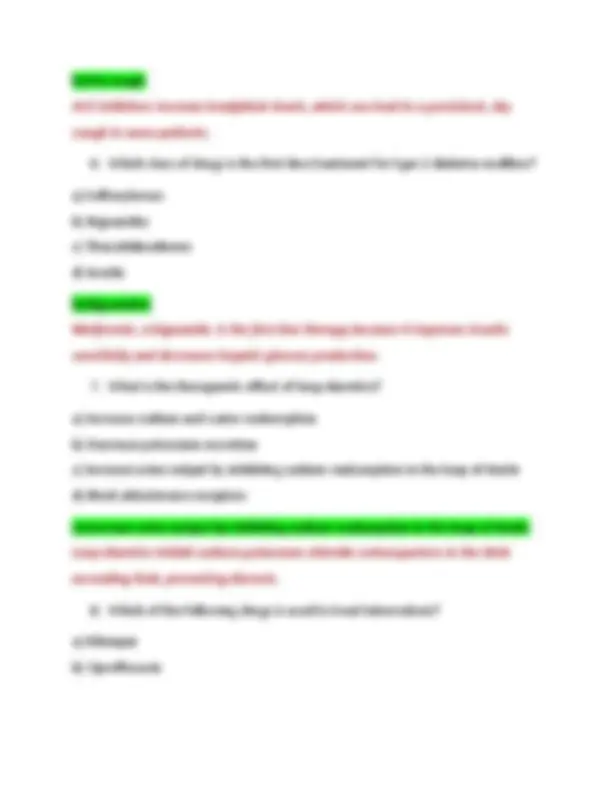
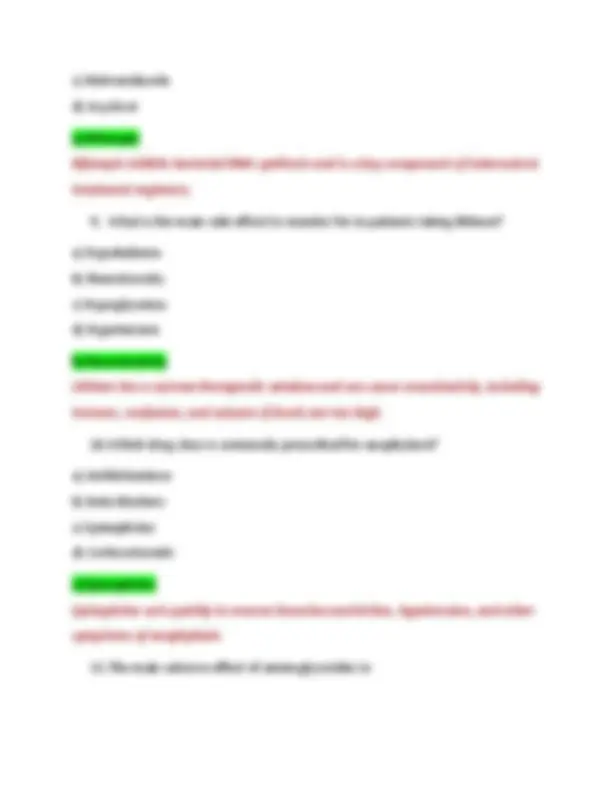
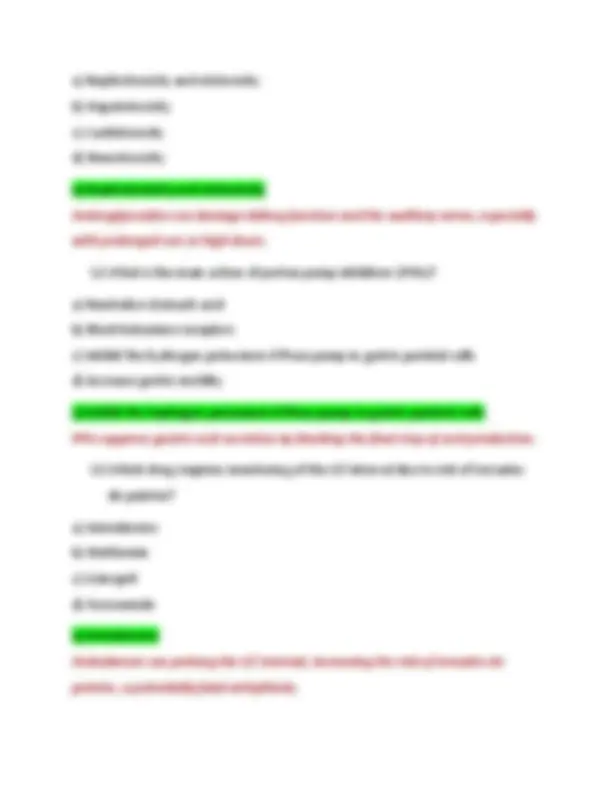
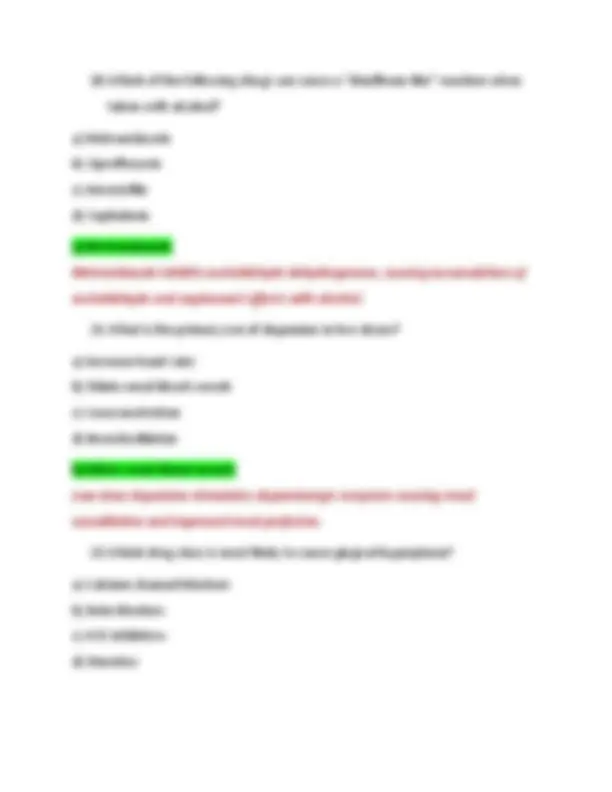
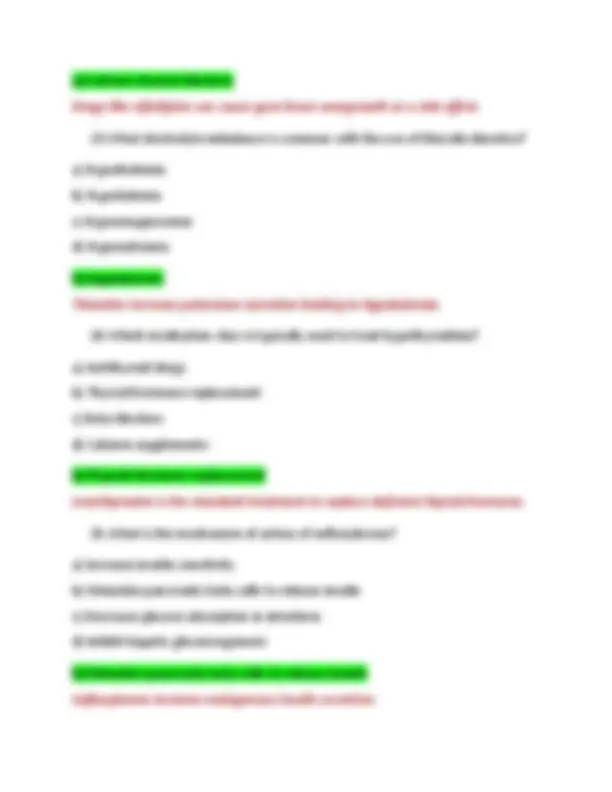
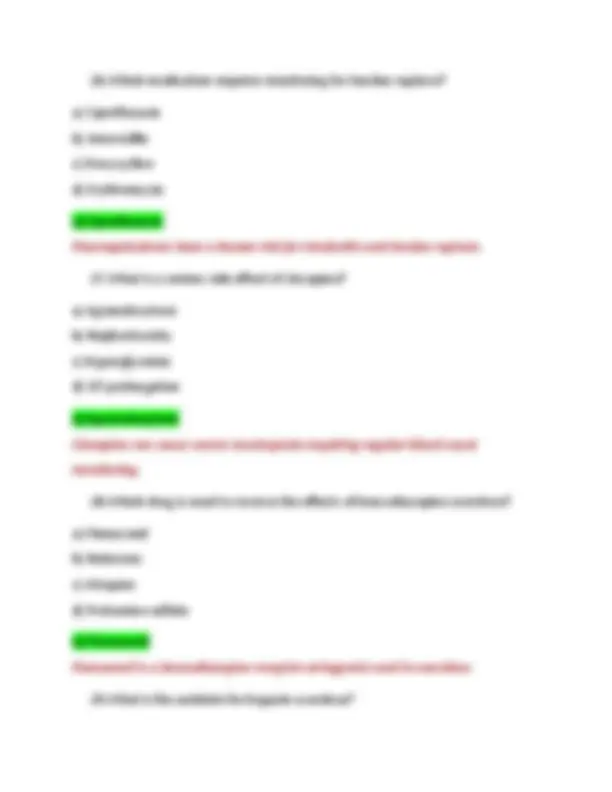
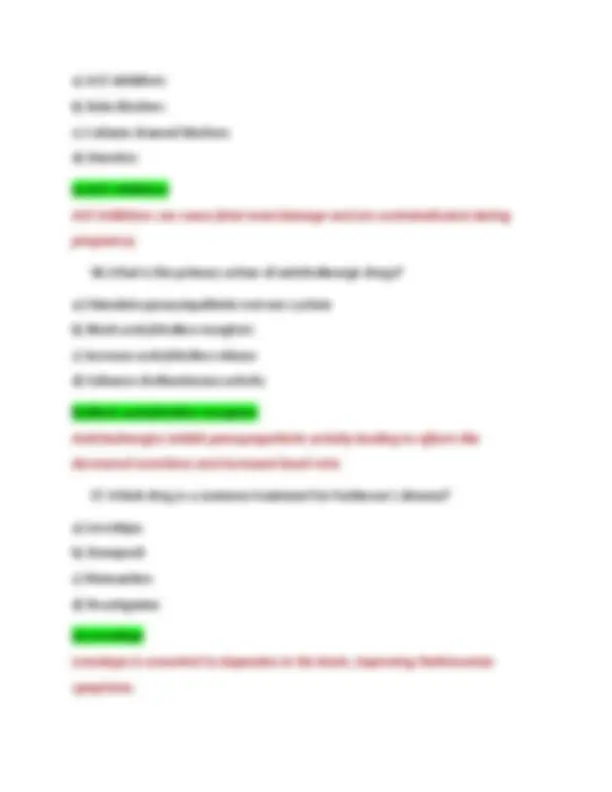
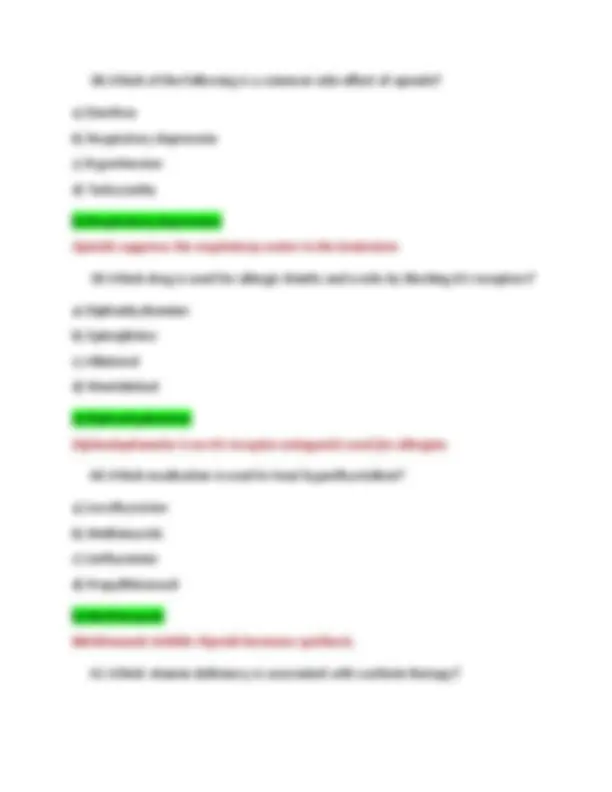
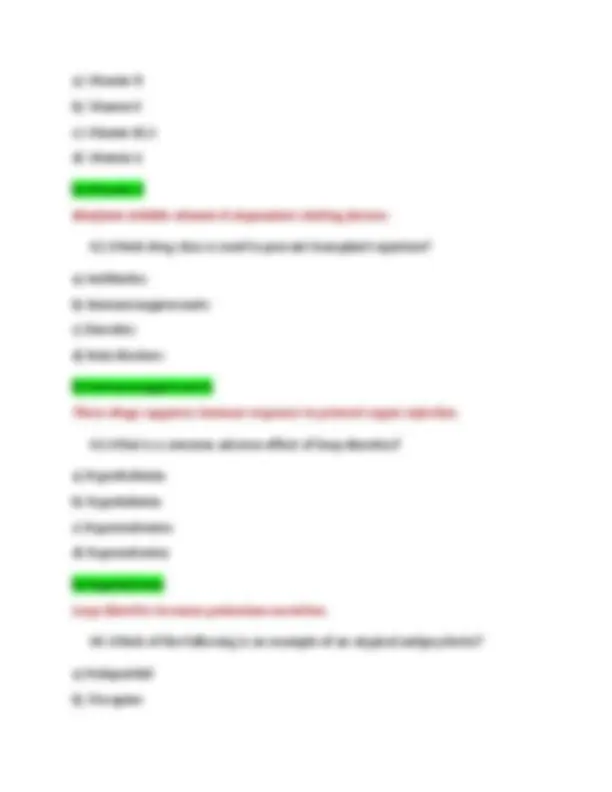
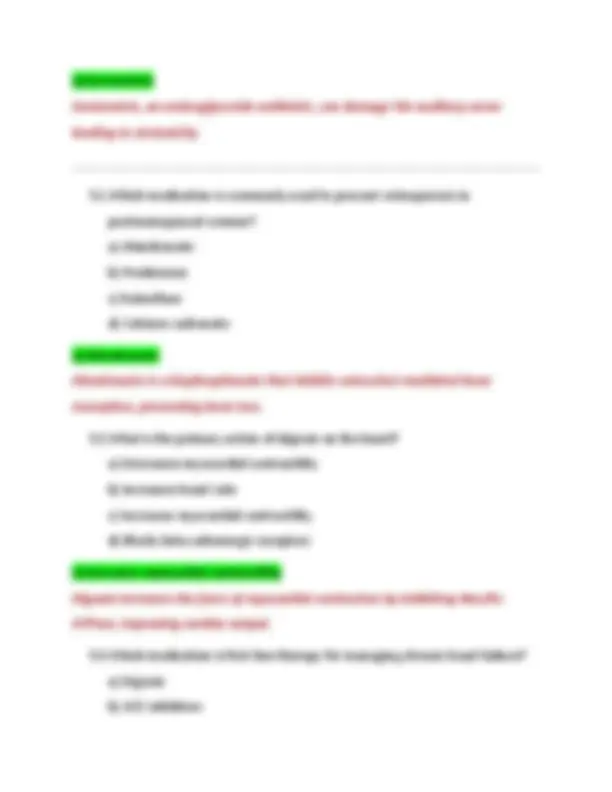
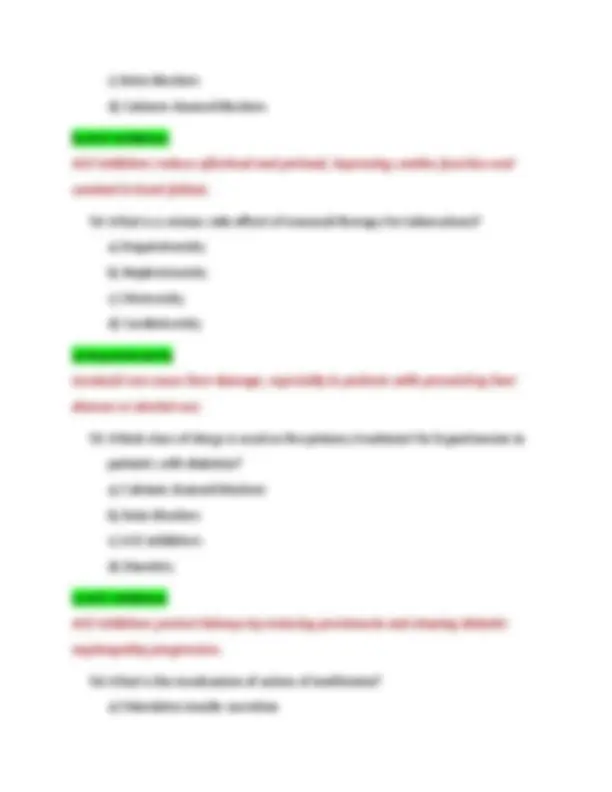
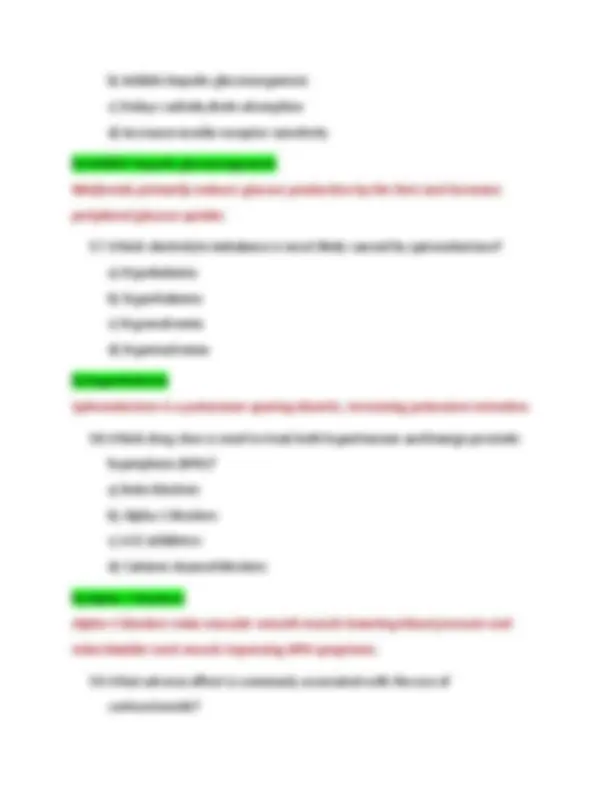
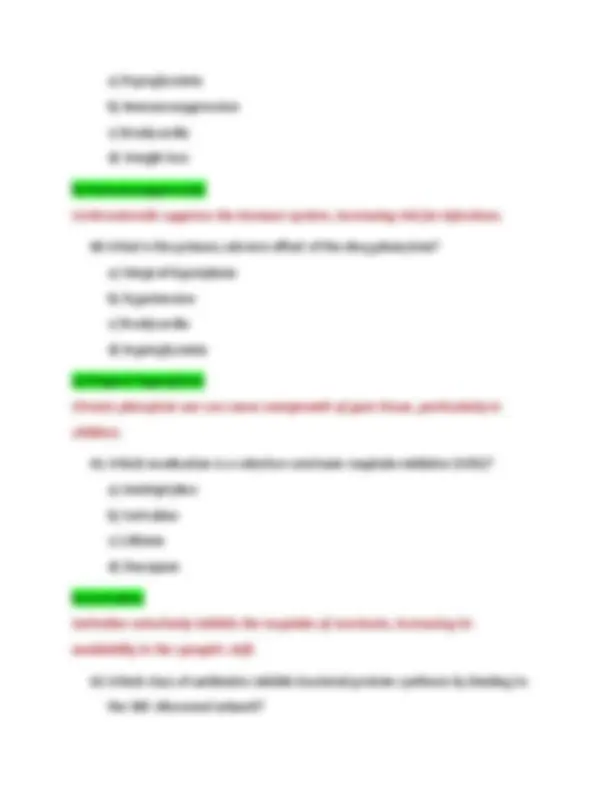
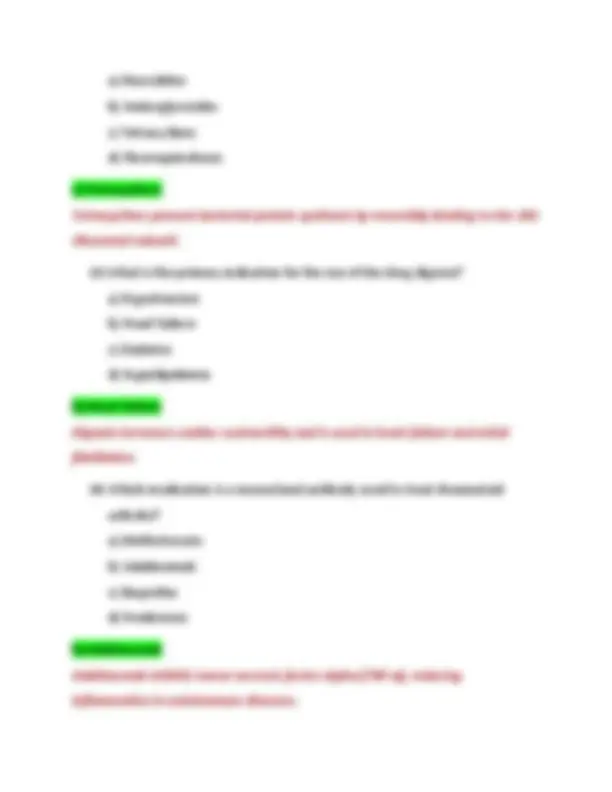
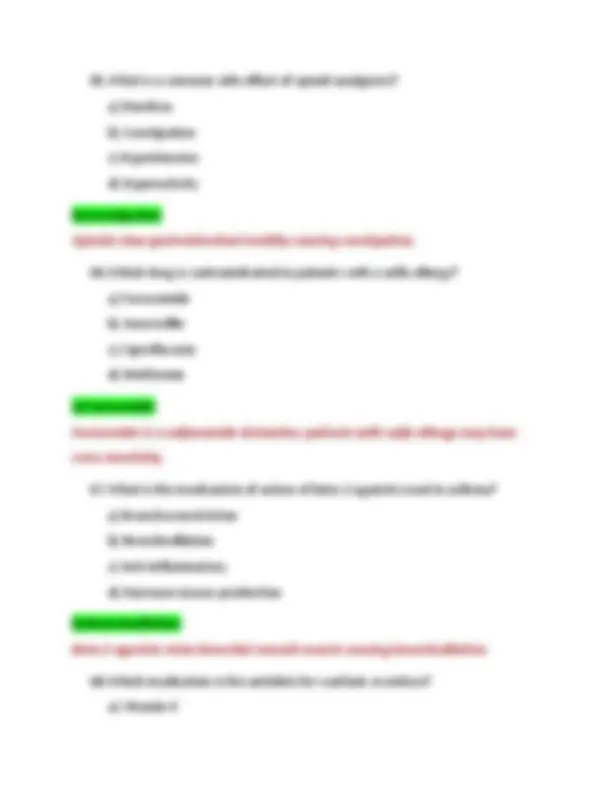
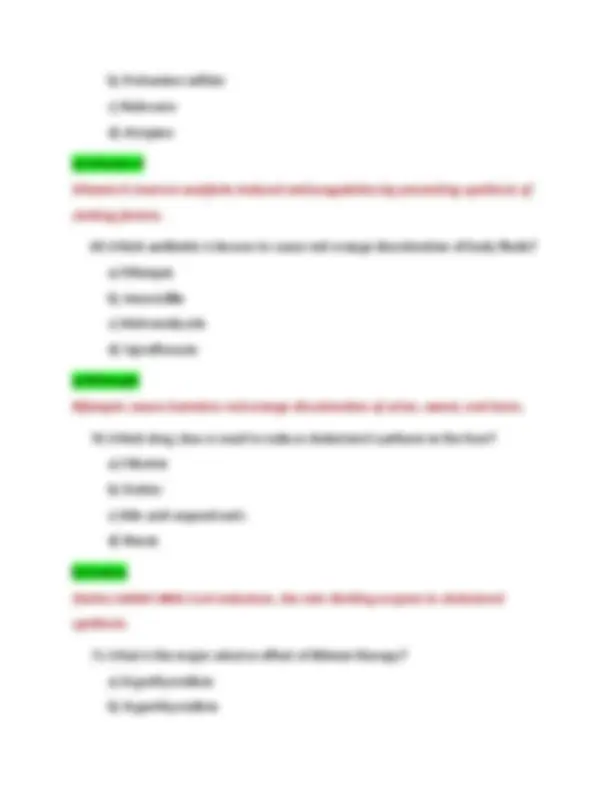
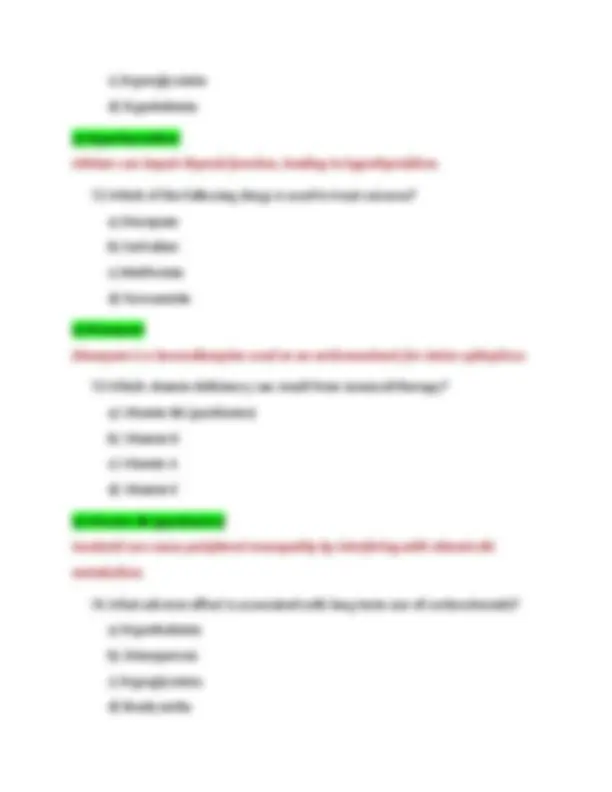
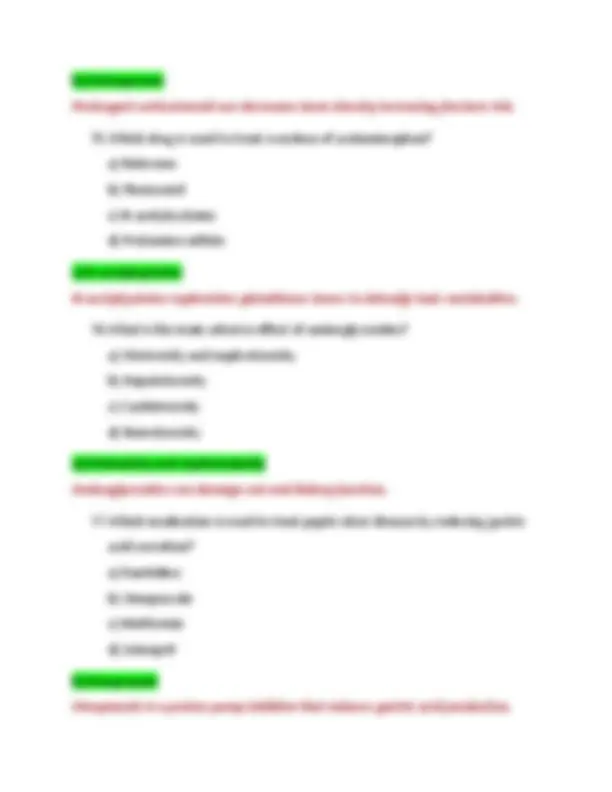
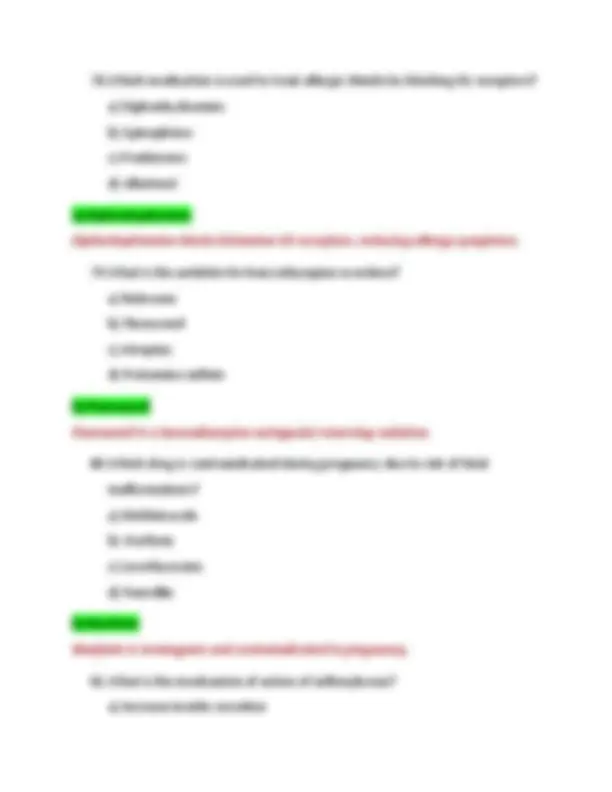
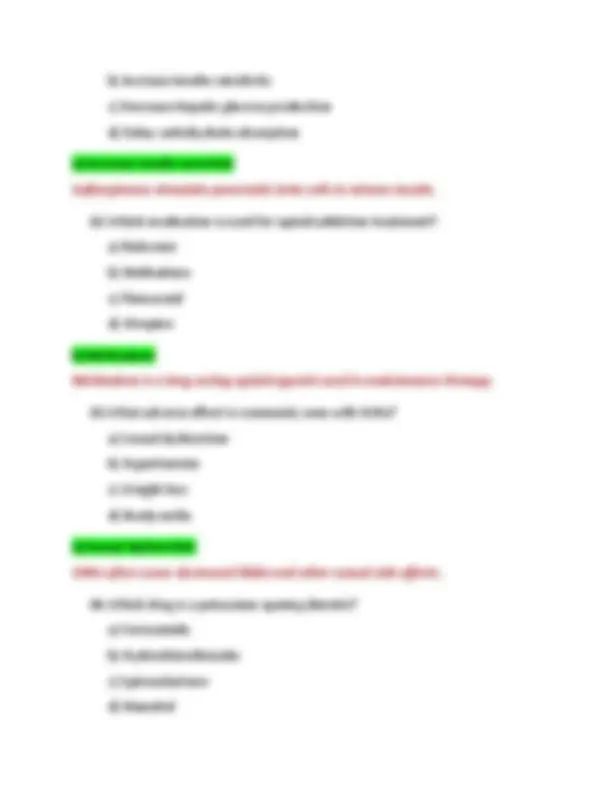
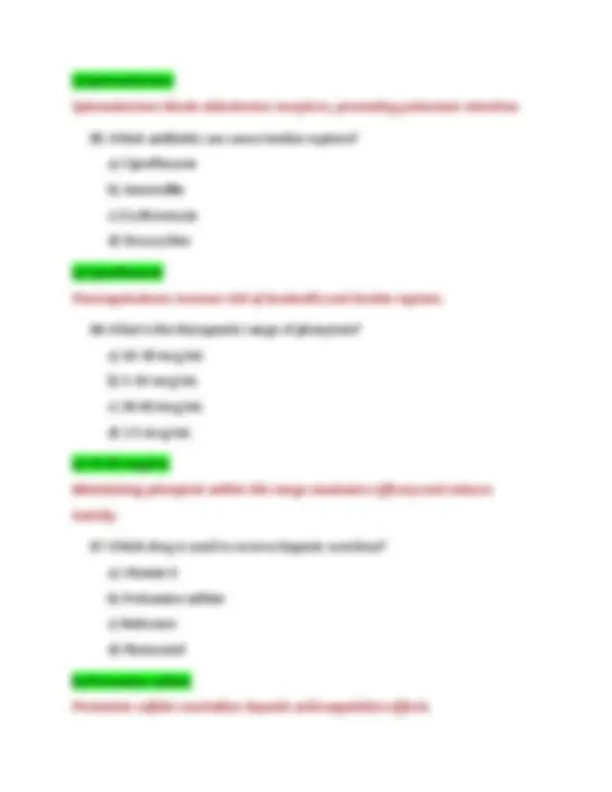
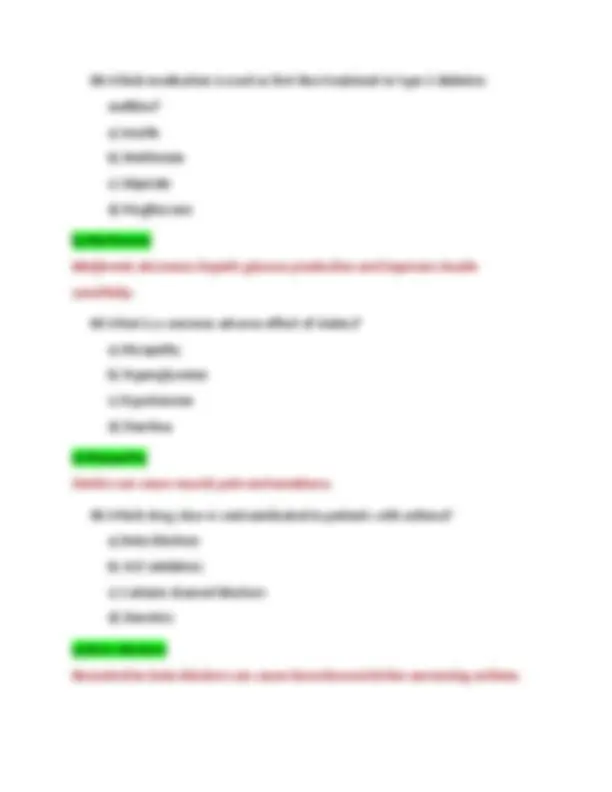
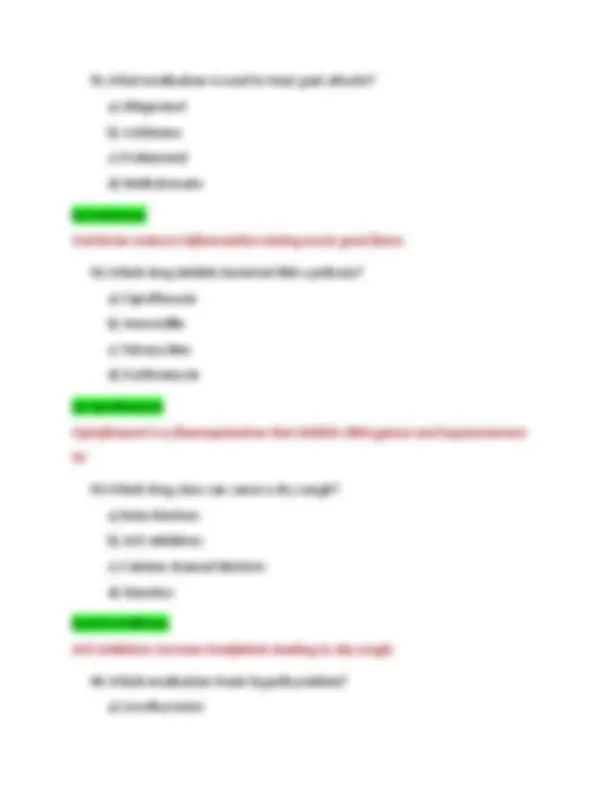
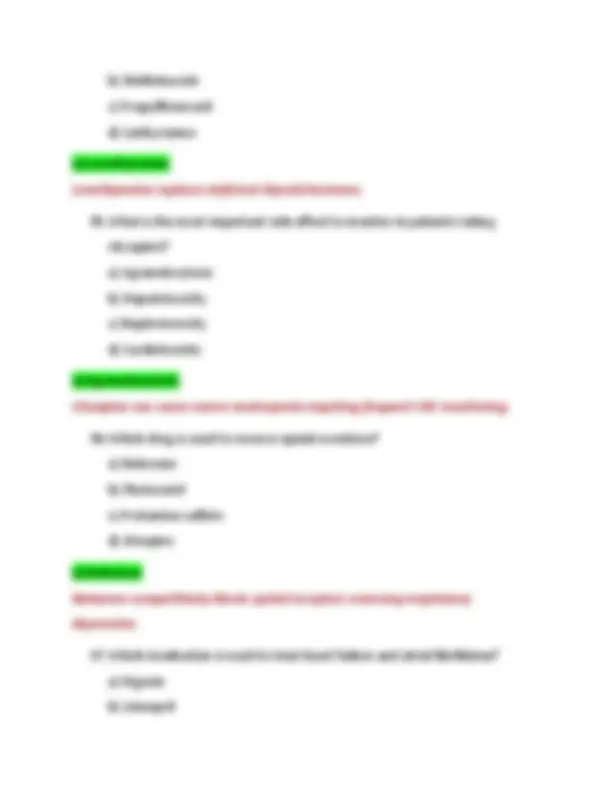
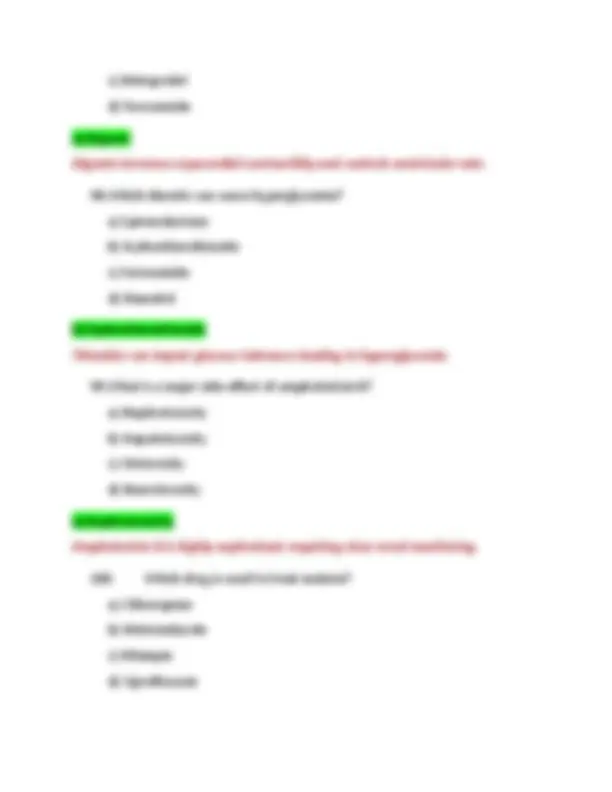
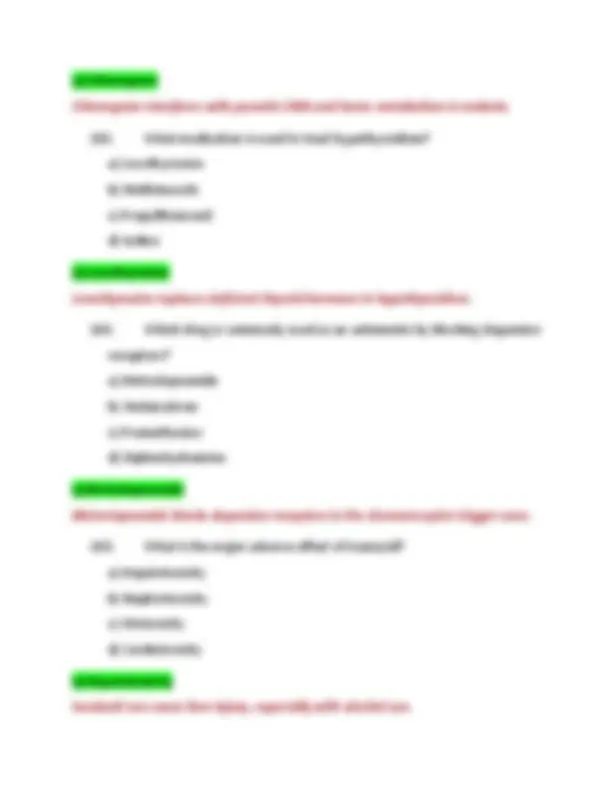
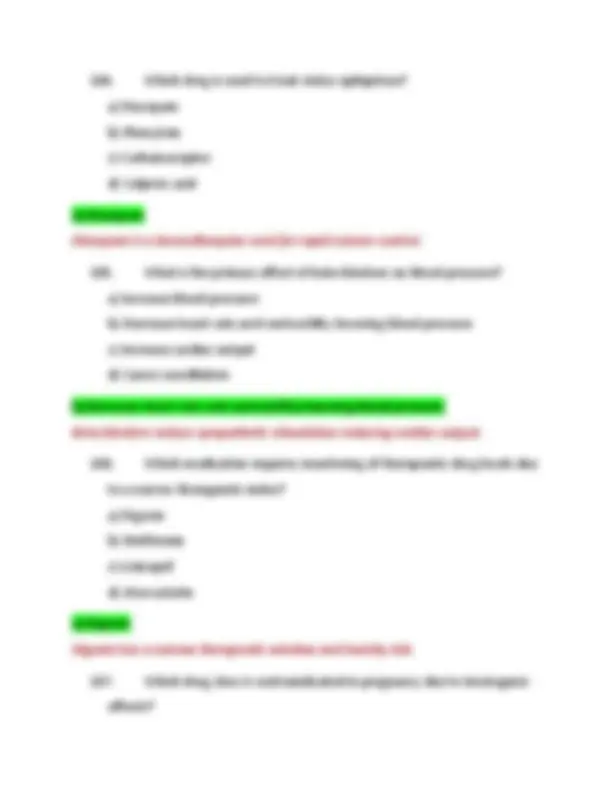
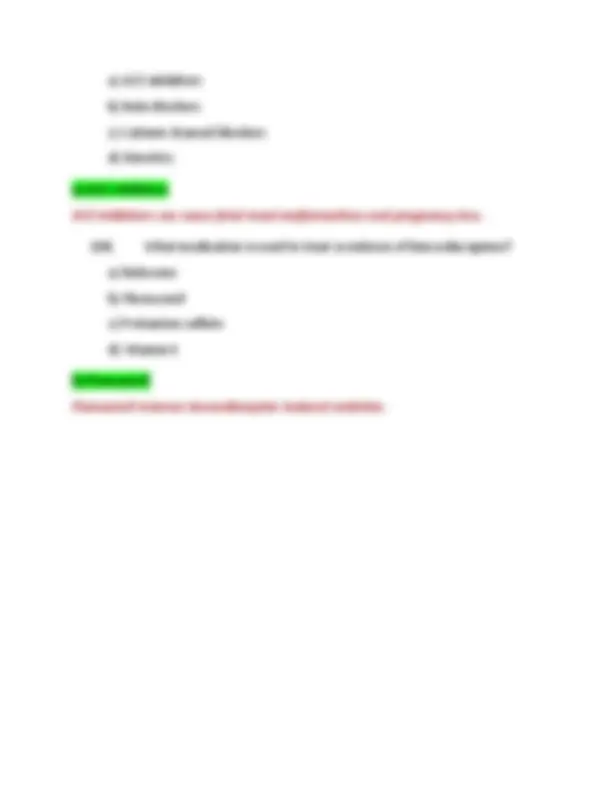


Study with the several resources on Docsity

Earn points by helping other students or get them with a premium plan


Prepare for your exams
Study with the several resources on Docsity

Earn points to download
Earn points by helping other students or get them with a premium plan
Community
Ask the community for help and clear up your study doubts
Discover the best universities in your country according to Docsity users
Free resources
Download our free guides on studying techniques, anxiety management strategies, and thesis advice from Docsity tutors
NURS 5334 Pharm 2024/2025 University Of Texas - Arlington Latest Update Best Exam Solution Graded A+
Typology: Exams
1 / 36

This page cannot be seen from the preview
Don't miss anything!





























c) Metronidazole d) Acyclovir a) Rifampin Rifampin inhibits bacterial RNA synthesis and is a key component of tuberculosis treatment regimens.
a) Nephrotoxicity and ototoxicity b) Hepatotoxicity c) Cardiotoxicity d) Neurotoxicity a) Nephrotoxicity and ototoxicity Aminoglycosides can damage kidney function and the auditory nerve, especially with prolonged use or high doses. 12.What is the main action of proton pump inhibitors (PPIs)? a) Neutralize stomach acid b) Block histamine receptors c) Inhibit the hydrogen-potassium ATPase pump in gastric parietal cells d) Increase gastric motility c) Inhibit the hydrogen-potassium ATPase pump in gastric parietal cells PPIs suppress gastric acid secretion by blocking the final step of acid production. 13.Which drug requires monitoring of the QT interval due to risk of torsades de pointes? a) Amiodarone b) Metformin c) Lisinopril d) Furosemide a) Amiodarone Amiodarone can prolong the QT interval, increasing the risk of torsades de pointes, a potentially fatal arrhythmia.
a) Increase prostaglandin synthesis b) Inhibit phospholipase A2, decreasing arachidonic acid release c) Stimulate leukocyte production d) Increase capillary permeability b) Inhibit phospholipase A2, decreasing arachidonic acid release Corticosteroids suppress inflammation by inhibiting the release of inflammatory mediators. 18.Which medication is used as first-line treatment for an acute asthma attack? a) Salmeterol b) Montelukast c) Albuterol d) Theophylline c) Albuterol Albuterol is a short-acting beta-2 agonist used for quick relief of bronchospasm. 19.A patient taking digoxin should be monitored for: a) Hyperkalemia b) Hypokalemia c) Hypercalcemia d) Hypomagnesemia b) Hypokalemia Low potassium levels increase digoxin toxicity risk, causing arrhythmias.
20.Which of the following drugs can cause a "disulfiram-like" reaction when taken with alcohol? a) Metronidazole b) Ciprofloxacin c) Amoxicillin d) Cephalexin a) Metronidazole Metronidazole inhibits acetaldehyde dehydrogenase, causing accumulation of acetaldehyde and unpleasant effects with alcohol. 21.What is the primary use of dopamine in low doses? a) Increase heart rate b) Dilate renal blood vessels c) Vasoconstriction d) Bronchodilation b) Dilate renal blood vessels Low-dose dopamine stimulates dopaminergic receptors causing renal vasodilation and improved renal perfusion. 22.Which drug class is most likely to cause gingival hyperplasia? a) Calcium channel blockers b) Beta-blockers c) ACE inhibitors d) Diuretics
26.Which medication requires monitoring for tendon rupture? a) Ciprofloxacin b) Amoxicillin c) Doxycycline d) Erythromycin a) Ciprofloxacin Fluoroquinolones have a known risk for tendonitis and tendon rupture. 27.What is a serious side effect of clozapine? a) Agranulocytosis b) Nephrotoxicity c) Hyperglycemia d) QT prolongation a) Agranulocytosis Clozapine can cause severe neutropenia requiring regular blood count monitoring. 28.Which drug is used to reverse the effects of benzodiazepine overdose? a) Flumazenil b) Naloxone c) Atropine d) Protamine sulfate a) Flumazenil Flumazenil is a benzodiazepine receptor antagonist used in overdose. 29.What is the antidote for heparin overdose?
a) Vitamin K b) Protamine sulfate c) Naloxone d) Atropine b) Protamine sulfate Protamine sulfate binds and neutralizes heparin's anticoagulant effects. 30.Which of the following is a common adverse effect of statins? a) Muscle pain b) Hypertension c) Hyperglycemia d) Bradycardia a) Muscle pain Statins can cause myopathy and rarely rhabdomyolysis. 31.Which antibiotic is contraindicated in children due to risk of teeth discoloration? a) Tetracycline b) Penicillin c) Erythromycin d) Ciprofloxacin a) Tetracycline Tetracyclines bind calcium in developing teeth causing permanent discoloration. 32.What is the therapeutic drug level range for lithium?
a) ACE inhibitors b) Beta-blockers c) Calcium channel blockers d) Diuretics a) ACE inhibitors ACE inhibitors can cause fetal renal damage and are contraindicated during pregnancy. 36.What is the primary action of anticholinergic drugs? a) Stimulate parasympathetic nervous system b) Block acetylcholine receptors c) Increase acetylcholine release d) Enhance cholinesterase activity b) Block acetylcholine receptors Anticholinergics inhibit parasympathetic activity leading to effects like decreased secretions and increased heart rate. 37.Which drug is a common treatment for Parkinson’s disease? a) Levodopa b) Donepezil c) Memantine d) Rivastigmine a) Levodopa Levodopa is converted to dopamine in the brain, improving Parkinsonian symptoms.
38.Which of the following is a common side effect of opioids? a) Diarrhea b) Respiratory depression c) Hypertension d) Tachycardia b) Respiratory depression Opioids suppress the respiratory center in the brainstem. 39.Which drug is used for allergic rhinitis and works by blocking H1 receptors? a) Diphenhydramine b) Epinephrine c) Albuterol d) Montelukast a) Diphenhydramine Diphenhydramine is an H1 receptor antagonist used for allergies. 40.Which medication is used to treat hyperthyroidism? a) Levothyroxine b) Methimazole c) Liothyronine d) Propylthiouracil b) Methimazole Methimazole inhibits thyroid hormone synthesis. 41.Which vitamin deficiency is associated with warfarin therapy?
c) Chlorpromazine d) Fluphenazine b) Clozapine Clozapine is an atypical antipsychotic with lower risk of extrapyramidal symptoms. 45.What medication is commonly used to treat peptic ulcer disease? a) Omeprazole b) Metformin c) Furosemide d) Diazepam a) Omeprazole Omeprazole reduces gastric acid secretion, allowing ulcer healing. 46.Which drug is used to treat an overdose of benzodiazepines? a) Naloxone b) Flumazenil c) Protamine sulfate d) Vitamin K b) Flumazenil Flumazenil reverses benzodiazepine effects by antagonizing GABA receptors. 47.What is the therapeutic use of digoxin? a) Hypertension b) Heart failure and atrial fibrillation
c) Diabetes mellitus d) Asthma b) Heart failure and atrial fibrillation Digoxin increases cardiac contractility and controls ventricular rate. 48.Which medication is used as a long-term treatment for gout? a) Allopurinol b) Colchicine c) Ibuprofen d) Prednisone a) Allopurinol Allopurinol reduces uric acid production. 49.What is the mechanism of action of beta-2 agonists in asthma? a) Bronchoconstriction b) Bronchodilation c) Anti-inflammatory effect d) Mucus production b) Bronchodilation Beta-2 agonists relax smooth muscle of the airways. 50.Which medication can cause ototoxicity as a side effect? a) Gentamicin b) Amoxicillin c) Ciprofloxacin d) Erythromycin
c) Beta-blockers d) Calcium channel blockers b) ACE inhibitors ACE inhibitors reduce afterload and preload, improving cardiac function and survival in heart failure. 54.What is a serious side effect of isoniazid therapy for tuberculosis? a) Hepatotoxicity b) Nephrotoxicity c) Ototoxicity d) Cardiotoxicity a) Hepatotoxicity Isoniazid can cause liver damage, especially in patients with preexisting liver disease or alcohol use. 55.Which class of drugs is used as the primary treatment for hypertension in patients with diabetes? a) Calcium channel blockers b) Beta-blockers c) ACE inhibitors d) Diuretics c) ACE inhibitors ACE inhibitors protect kidneys by reducing proteinuria and slowing diabetic nephropathy progression. 56.What is the mechanism of action of metformin? a) Stimulates insulin secretion
b) Inhibits hepatic gluconeogenesis c) Delays carbohydrate absorption d) Increases insulin receptor sensitivity b) Inhibits hepatic gluconeogenesis Metformin primarily reduces glucose production by the liver and increases peripheral glucose uptake. 57.Which electrolyte imbalance is most likely caused by spironolactone? a) Hypokalemia b) Hyperkalemia c) Hyponatremia d) Hypernatremia b) Hyperkalemia Spironolactone is a potassium-sparing diuretic, increasing potassium retention. 58.Which drug class is used to treat both hypertension and benign prostatic hyperplasia (BPH)? a) Beta-blockers b) Alpha-1 blockers c) ACE inhibitors d) Calcium channel blockers b) Alpha-1 blockers Alpha-1 blockers relax vascular smooth muscle lowering blood pressure and relax bladder neck muscle improving BPH symptoms. 59.What adverse effect is commonly associated with the use of corticosteroids?